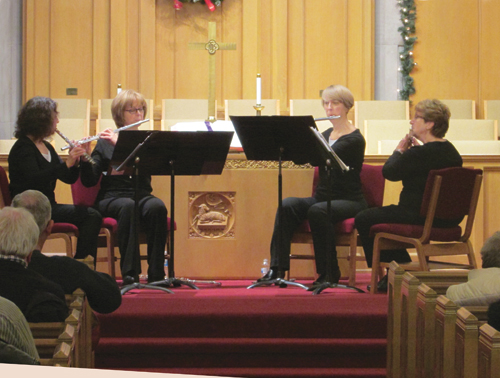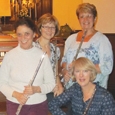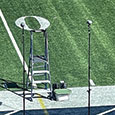
Being a member of a flute ensemble, either as a professional or an adult amateur, can be a rewarding and enjoyable experience. Whether performing at a school, wedding, senior citizen center, or recital hall, members of a good flute ensemble will find many opportunities to play for appreciative audiences. If a community does not have an established flute ensemble, consider starting one.
First Considerations
Construct a plan to organize your goals, so you can effectively and efficiently sell your plan to your community. Decide what kind of flute ensemble you want to start. Some groups are as small as four players and concentrate on the repertoire featuring four C flutes or four flutists playing piccolo, C flute, alto and bass. Standard flute choir repertoire has parts for piccolo, flutes 1, 2, 3 (and possibly 4), alto, bass, and optional contra, so this music requires a minimum of seven to eight flutists. Many larger flute choirs play this repertoire using multiples of flutists on the C flute, alto, and bass parts and generally have between twelve and forty members.
To determine the instrumentation of your group consider the availability of local musicians at the appropriate performance level, especially players for piccolo, alto, bass and contrabass flute. It is ideal if at least one person can also play piano.
If you live in a small community, avoid starting a group with the same instrumentation as an existing ensemble. The competition for similar performance opportunities could cause uneasy feelings. For example, if a community already has an active flute quartet, there is nothing wrong with starting a flute trio or flute choir. At the very least, communicate directly with members of another group if you plan to use identical instrumentation. This would not be a concern in a larger city where there are enough opportunities for all.
With small ensembles, it is easier to schedule rehearsal and performance times, and rehearsals can take place in one of the flutist’s homes. However, while some things may be more difficult for a large flute choir, there are many benefits such as access to instruments (especially the low flutes), music, rehearsal and performance venues, and of course the added joy of getting together with a larger group of musicians.
Another point to consider in choosing the size of the ensemble will be whether you wish to start a group that primarily plays paid jobs or is a concert ensemble. If you wish to chiefly play jobs, then scheduling will be easier with a fewer number of flutists involved.
If you wish to start a concert ensemble, decide how many concerts you wish to perform each year. Many of the larger flute choirs play at least four concerts a year, each with different repertoire. Fall concerts will often have Halloween or Christmas themes while the two spring concert programs might have varied repertoire. Due to vacation schedules, larger flute choirs are often less active during summer months. Of course, certain programs may be presented several times around the community or in neighboring towns and cities. Some larger groups also break down into smaller groups for paid performances.
Choose a rehearsal time with care. Unless the mission of the group is only to play for fun, consistent rehearsals are a necessity for a successful performance group. Attendance of all ensemble members at rehearsals is crucial and should be expected. Members who are employed may have work schedule changes that necessitate a new rehearsal time. Be patient with these changes but make it a priority to find a regular rehearsal time. One tip is to schedule concerts at the same time as rehearsals as members have already reserved this time and will be available to perform. Rehearsals are generally scheduled for 90 to 120 minutes. Many flute choirs find Monday and Thursday evenings or Sunday afternoons to be excellent days to rehearse and perform.
Select a rehearsal and concert venue. Many churches offer free rehearsal space if the group will perform occasionally at services or events. Other locations that work are school band and choir rooms (public school, university, or community college), art center facilities, meeting rooms at a public library, and meeting rooms at a local business facility.
The ensemble’s name should be distinctive and catchy, but not trite. Be sure to avoid names used by other groups. Search the internet to be sure there is no other group using a name because if you should ever apply for non-profit status, the request will be denied if the name is already in use.
Assembling a Group
If you decide to start a small group, then you probably already know who you will invite. However, if you want to form a community-wide ensemble, make up a flier announcing your plans. Of course these plans may be changed or augmented once the group has assembled, but having something stated in black and white will help attract potential members because they know all the facts.

Place the flier in appropriate venues around town (library, schools, stores, church bulletins). Send it to music teachers at the area high schools, colleges, music stores, and church musicians. Where possible arrange to be interviewed by local newspapers and television stations.
If you want to hold auditions for the group, then add to the flier that there will be a 30-minute organizational meeting followed by 5-minute auditions. Include the audition material on the flier, such as a 3-minute excerpt from a piece of the flutist’s choice and a short sightreading selection. Of course, you may choose to waive the audition for a flutist you already know. In any event, choose members of an ensemble very carefully. Generally, people of similar ability, playing level and age are preferable. Strive to find players who have a similar mission, whether it is to play advanced literature, satisfy a need for a working chamber group in the community, educate young people or just have fun rehearsing together. If players differ too much in philosophy, it can be frustrating. However, that is not to say that a mixed group of mature players, who each mentor a younger player, could not be a wonderful experience for all.
Do not hesitate to invite players who were not music majors in college. There are many fine flute players who did not choose music as a career. As a matter of fact, you will find that those from different circles will bring contacts for performances to your group that you may not have had otherwise. They can bring a fresh, new perspective as well.
Although the need for a substitute player may never come up, think about that possibility in advance and consider a solution before the problem occurs. A substitute should be a fine flutist, who that can step in with limited group rehearsal time. In an emergency, you cannot predict which part will need to be filled so excellent sightreading skills are essential.
The Meeting
Be organized and use the time effectively. Have everyone sign an information sheet that includes name, address, phone number, email, and flutes the person owns and is comfortable playing. Share your ideas such as group name and rehearsal and performance plans. A simple ballot with these items listed can be used to solidify the plans. If you choose not to hold auditions, a rehearsal could follow the meeting. Prepare a warm-up sheet for the group similar to what a concert band would use. Then have several reading selections to assess the strengths and weaknesses of the group. Finish with punch and cookies and get acquainted.
Another topic to be decided is whether there will be a yearly fee for participation. This fee (perhaps $25-50) helps pay for the purchase of music, printing and publicity for the concerts.
A music library is often the most costly part of setting up a musical ensemble. If a player is a member of the National Flute Association, it is possible to borrow music from that organization. Libraries may allow inter-library loans of music from universities and colleges, and there are some internet sites that provide free public domain music that you can print out. Be careful about borrowing music from other groups because sometimes only the purchasing group has permission to use it. Good flute ensemble libraries include music of all genres and ability levels.
Other options are to solicit contributions from ensemble members or hold fundraisers such as the sale of music-related, handmade products at concerts or other venues. Of course, the surest way to earn money for music and other expenses is to charge admission to the group’s performances.
Building an Audience
Look for opportunities to combine your group with another flute ensemble for occasional performances. This opens up more performance venues and may attract larger audiences. The group will also benefit by experiencing new and refreshing music and ideas. Small adult flute ensembles may decide to include student flutists in some of the performances. This creates a wonderful experience for young people and increases the size of your audience, as they tend to bring large numbers of family members and friends.
Advertising is crucial to building an audience and becoming recognized as a musical ensemble in the community. Members usually do the majority of the advertising. Personal contacts or letters to school teachers, school parent organizations, public libraries, church music ministers, senior citizens centers, assisted living facilities, nursing homes, community arts councils, art studios and wedding consultants are some of the contacts to pursue. Local newspapers will often print an article about a new group in the community, or a group that is preparing for a local performance. Weekly church bulletins announce upcoming performances (and church members are often avid concert-goers). Explore with social networking to advertise the group’s functions to a large audience. Attractive posters and brochures can be placed on the bulletin boards of school music rooms, stores, restaurants and other public places. Advertisements can be purchased in the ad section of newspapers, community theatre playbills, concert programs, television community calendars, restaurant placemats, on-line community networks and many more places. An up-to-date internet website is a necessity in order to contend in today’s market. Once several performances are lined up, the ensemble will start to get a reputation, and other invitations will develop through word of mouth.
Whenever possible, schedule performances at churches, libraries, schools, organizations and service groups that can provide you with advertising and can apply for grants and other services on your behalf, based on their non-profit status.
Honorariums
The question of whether to expect payment for services is one that is important for the ensemble members to discuss at the beginning and before you start advertising or accepting invitations to play for events. Performers who have received music or performance degrees usually expect to be compensated. Often, players who have a non-music degree are not accustomed to being paid for performing. Various events are often handled differently; for instance, it is expected that musicians playing for weddings will receive payment for their services, but those playing for community fundraisers often donate their service to the cause. Churches sometimes expect visiting groups to play for free; many times an in-kind benefit is worked out between a performing group and a church or a member of that church. (For instance, an ensemble that uses church facilities for weekly rehearsals, may gladly to play at services of that church several times during the year). A rule of thumb is that if your ensemble practices regularly and performs at an advanced level, most performances should be for compensation.
If you do charge for the ensemble’s services, use a printed contract to be completed by the hiring organization and signed by a representative of that organization and a representative of your ensemble. A contract could be a simple document, including the date, location, occasion, start and end time, type of music or list of specific music to be played, instrumentation agreed upon, price agreed upon, needs of the chamber ensemble, and due date of the signed contract. If performing in a church or for a religious ceremony, ask that special music requirements be stated in the contract.
Remember to specify any special considerations for outdoor functions and include two copies so that the organization or individual hiring your group can keep one copy and return the other to you.
Outside performances are quite common, but they take special arrangements, depending on the season and climate. Some groups routinely refuse outdoor performances, but they may be a good option with the proper stipulations stated in the contract. (Indeed, an ensemble may not get many contracts for weddings if outdoor events are refused.) Be very clear that you will not play unprotected in the rain, sun, or if the temperature is below a certain degree. Some ensembles in northern states will not consider an outdoor function after a certain date in the fall. Keep in mind that use of a piano may not be possible outside and special care will have to be taken to keep the music on the stand in windy weather. If you wish to sit, specify that you want armless chairs in the contract, as well any other items such as stands, piano, lights and other equipment. (Many flute ensembles prefer to supply their own music stands). Outdoor performances can be a challenge but are feasible with careful advance planning.
What to Wear
Another issue that the group should discuss is whether to dress identically during performances. Uniforms eliminate the quandary of what to wear and usually assure a nice appearance on stage. However, they can cause discomfort if all members are not the same body shape or do not share the same taste in style. Sometimes, especially during a theme performance, it is fun to dress to complement the program.
Another option is for all ensemble members to wear the same color but choose their own styles. Whether the group all dresses the same or not, decide on standards of appearance so that all members appear professional and appropriate for the activity.
Dividing Up the Duties
Each person in an ensemble should take on a business role in the group. It can be as simple as treasurer, librarian, manager and secretary. Find out what non-musical skills members have. For example, one person might be great at web design while another may have a background in accounting. Clear delineation of responsibilities helps ensure that everything is accomplished and avoid conflicts in the future. The following are a few options for division of job responsibilities:
Treasurer:
• Collects money at all functions and records the total, making sure that there is a paper trail between the function and the bank.
• Deposits money into a bank account and provides each member with a copy of the monthly or quarterly statement.
• Keeps up-to-date accounting of all activities in the account.
• Promptly writes checks to members and vendors for equipment or services provided.
Librarian:
• Stamps all new or incoming music with the name of the ensemble and takes responsibility for filing and keeping library records.
• Becomes familiar with music loaning institutions or organizations (such as NFA or University Inter-Library Loan) so that music not owned by the group is available.
• Becomes familiar with copyright laws so the ensemble does not find itself in violation.
• Distributes and assigns music to members. Unless the group has made a conscious decision to the contrary, many ensembles rotate parts among members so that players do not always play the same part. Of course, some players own auxiliary flutes (piccolo, alto and bass) so those parts will be routinely assigned to them.
• Brings scores and extra parts to all rehearsals in case a player forgets a part.
• Collates, accounts for, files away original music and destroys any copies when music is turned in.
Manager:
• Serves as the contact person for all groups or people who wish to hire the group or set up a performance.
• Handles information and contracts for all ensemble business matters.
• Writes and submits newspaper publicity releases regarding upcoming performances.
• Creates advertising documents such as posters or flyers. (All members should participate in the distribution of the advertisement documents to spread the information as widely as possible.)
• Arranges equipment and set-up requirements with hiring organizations.
Secretary:
• Takes charge of all correspondence to individuals or community organizations.
• Takes notes at all business meetings of the ensemble and makes them available to members.
• Keeps historical records for the organization, including, but not limited to, printed programs, yearly rosters, names and contact information for all the current members and possible substitutes.
• Arranges a rehearsal space with proper equipment.
At an early stage, it is also important to determine how the group will make decisions. A strict democracy among a small group of peers may work well, but in a larger organization, or one with a number of younger members, the group organizer or an elected leader may need to make some choices. Other things to consider are how to handle personal conflicts and members who fail to come to rehearsals or who do not complete their job responsibilities. Preparing a written code of behavior and procedures for resolving conflicts in advance, avoids the problem of making difficult choices when tempers are high.
Starting a flute ensemble for enjoyment or profit takes some work but is well worth the time and effort. It can lead to new friendships, rewarding experiences, and increased knowledge of performance practices and music written for your ensemble.






